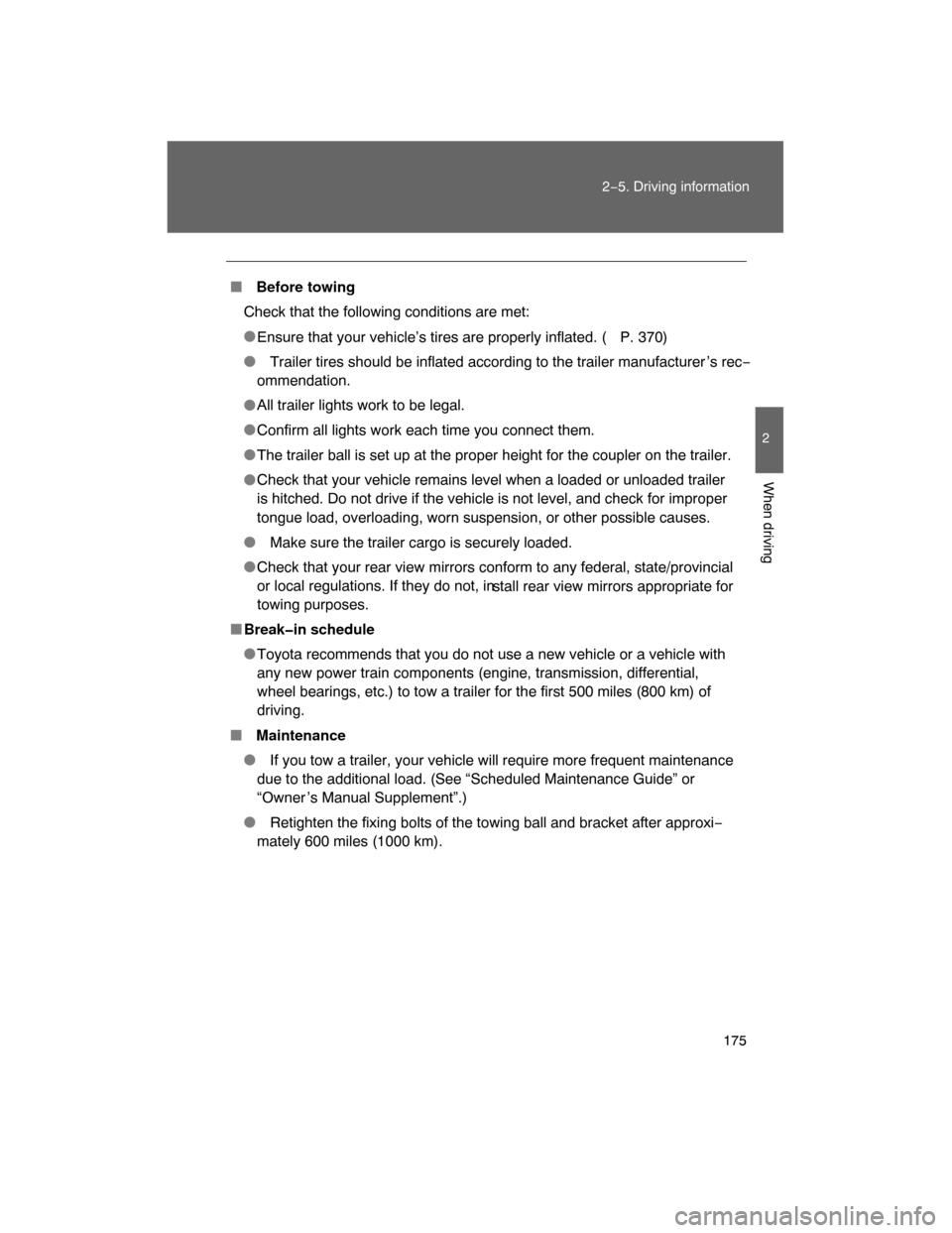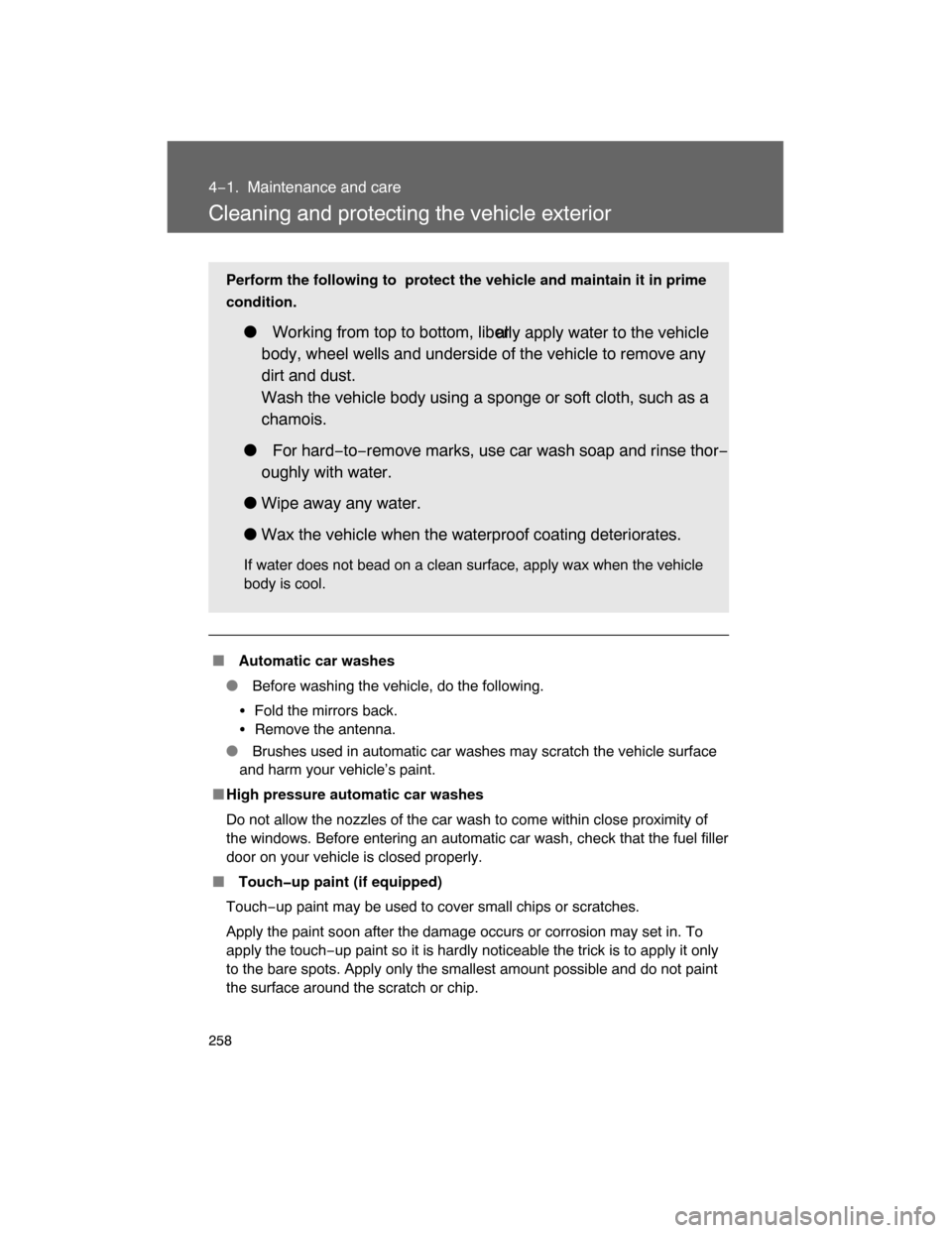Page 60 of 400
61
1−3. Adjustable components (seats, mirrors, steering wheel)
1
Before driving
NOTICE
� If ice should jam the mirror
Do not operate the control or scrape the mirror face. Use a spray de−icer to
free the mirror.
Page 106 of 400

108 2−1. Driving procedures
CAUTION
� When driving the vehicle
� Do not shift the shift lever to N while the vehicle is moving.
Doing so may cause the engine brake to not operate properly and lead to
an accident.
� Do not turn the engine off while driving.
The power steering and brake booster systems will not operate properly if
the engine is not running.
� Use engine braking (downshift) to maintain a safe speed when driving
down a steep hill.
Using the brakes continuously may cause the brakes to overheat and lose
effectiveness. (
P. 1 1 8120)
�When stopped on an inclined surface, use the brake pedal and parking
brake to prevent the vehicle from rolling backward or forward and causing
an accident.
� Do not adjust the position of the steering wheel, the seat, or the inside or
outside rear view mirrors while driving.
Doing so may result in a loss of vehicle control that can cause accidents
that may result in death or serious injury.
� Always check that all passengers’ arms, heads or other parts of their bod−
ies are not outside the vehicle, as this may result in death or serious injury.
�
Do not drive in excess of the speed limit. Even if the legal speed limit per−
mits it, do not drive over 85 mph (140 km/h) unless your vehicle has high−
speed capability tires. Driving over 85 mph (140 km/h) may result in tire
failure, loss of control and possible injury. Be sure to consult a tire dealer
to determine whether the tires on your vehicle are high−speed capability
tires or not before driving at such speeds.
Page 129 of 400
131
2
When driving
2−3. Operating the lights and wipers
Headlight switch
Turning on the high beam headlights
With the headlights on, push
the lever forward to turn on the
high beams.
Pull the lever back to the center
position to turn the high beams
off.
Pull the lever toward you to
turn on the high beams.
Release the lever to turn them off.
You can flash the high beams
with the headlights on or off. The headlights can be operated manually.
The side marker, parking, tail, license plate, outside rear
view mirror illumination (if equipped) and instrument panel
lights turn on.
The headlights and all lights listed above turn on.
Page 167 of 400

169
2−5. Driving information
2
When driving
Winter driving tips
Carry out the necessary preparations and inspections before driving
the vehicle in winter. Always drive the vehicle in a manner appropri�
ate to the prevailing weather conditions.
� Pre�winter preparations
� Use fluids that are appropriate to the prevailing outside tem−
peratures.
�Engine oil
�Engine coolant
�Washer fluid
� Have a service technician inspect the level and specific grav−
ity of battery electrolyte.
�Have the vehicle fitted with four snow tires or purchase a set
of tire chains for the rear tires.
Ensure that all tires are the same size and brand, and that chains
match the size of the tires.
� Before driving the vehicle
Perform the following according to the driving conditions.
�
Do not try to forcibly open a window, scrape an outside rear
view mirror surface or move a wiper or outside rear view mir−
ror that is frozen. Pour warm water over the frozen area to
melt the ice. Wipe away the water immediately to prevent it
from freezing.
�To ensure proper operation of th e climate control system fan,
remove any snow that has accumulated on the air inlet vents
in front of the windshield.
�Remove any ice that has accumulated on the vehicle chassis.
�
Periodically check for and remo ve any excess ice or snow
that may have accumulated in the wheel well or on the
brakes.
Page 173 of 400

175
2−5. Driving information
2
When driving
� Before towing
Check that the following conditions are met:
�
Ensure that your vehicle’s tires are properly inflated. ( P. 370)
� Trailer tires should be inflated according to the trailer manufacturer ’s rec−
ommendation.
�All trailer lights work to be legal.
�Confirm all lights work each time you connect them.
�The trailer ball is set up at the proper height for the coupler on the trailer.
�Check that your vehicle remains level when a loaded or unloaded trailer
is hitched. Do not drive if the vehicle is not level, and check for improper
tongue load, overloading, worn suspension, or other possible causes.
� Make sure the trailer cargo is securely loaded.
�Check that your rear view mirrors conform to any federal, state/provincial
or local regulations. If they do not, in
stall rear view mirrors appropriate for
towing purposes.
�Break�in schedule
�Toyota recommends that you do not use a new vehicle or a vehicle with
any new power train components (engine, transmission, differential,
wheel bearings, etc.) to tow a trailer for the first 500 miles (800 km) of
driving.
� Maintenance
� If you tow a trailer, your vehicle will require more frequent maintenance
due to the additional load. (See “Scheduled Maintenance Guide” or
“Owner ’s Manual Supplement”.)
� Retighten the fixing bolts of the towing ball and bracket after approxi−
mately 600 miles (1000 km).
Page 254 of 400

258
4−1. Maintenance and care
Cleaning and protecting the vehicle exterior
� Automatic car washes
� Before washing the vehicle, do the following.
�Fold the mirrors back.
�Remove the antenna.
� Brushes used in automatic car washes may scratch the vehicle surface
and harm your vehicle’s paint.
�High pressure automatic car washes
Do not allow the nozzles of the car wash to come within close proximity of
the windows. Before entering an automatic car wash, check that the fuel filler
door on your vehicle is closed properly.
� Touch�up paint (if equipped)
Touch−up paint may be used to cover small chips or scratches.
Apply the paint soon after the damage occurs or corrosion may set in. To
apply the touch−up paint so it is hardly noticeable the trick is to apply it only
to the bare spots. Apply only the smallest amount possible and do not paint
the surface around the scratch or chip. Perform the following to protect the vehicle and maintain it in prime
condition.
� Working from top to bottom, liber
ally apply water to the vehicle
body, wheel wells and underside of the vehicle to remove any
dirt and dust.
Wash the vehicle body using a sponge or soft cloth, such as a
chamois.
� For hard−to−remove marks, use car wash soap and rinse thor−
oughly with water.
�
Wipe away any water.
�
Wax the vehicle when the waterproof coating deteriorates.
If water does not bead on a clean surface, apply wax when the vehicle
body is cool.
Page 308 of 400

312 4−3. Do−it−yourself maintenance
7 ECU−IG 10 AAnti−lock brake system, vehicle sta−
bility control system, traction con−
trol system, active traction control
system, AUTO LSD system, multi−
port fuel injection system/sequen−
tial multiport fuel injection system,
cruise control system, back door
lock system, shift lock system, mul−
tiplex communication system
8 IG1 15 ATurn signal lights, air conditioning
system, charging system, clutch
start cancel switch, anti−lock brake
system, traction control system,
active traction control system, vehi−
cle stability control system, AUTO
LSD system, back−up lights, intui−
tive parking assist, rear differential
lock system, power outlet, acces−
sory meter, meter and gauge
9 STA 7.5 AStarting system, clutch start cancel
switch, power outlet
10 TAIL 10 ATail lights, license plate lights, park−
ing lights, instrument panel light
control, illuminations
11 A C C 7 . 5 AShift lock system, outside rear view
mirrors, audio system, power out−
let, clock, accessory meter, multi−
plex communication system
12 POWER 30 A Power windows
FuseAmpereCircuit
Page 315 of 400
319
4−3. Do−it−yourself maintenance
4
Maintenance and care
� License plate lights
Remove the screws and cover.
Remove the light bulb.
� Lights other than the above
If any of the lights listed below has burnt out, have it replaced by
your Toyota dealer.
�Outside rear view mirror illumination lights
�High mounted stoplight